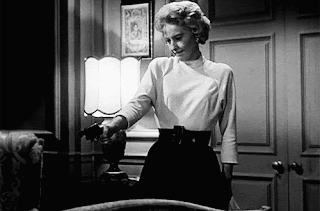 |
| David Niven and Olivia de Havilland in Raffles (1939) |
These films never show a woman holding a child. Associating women with motherhood has become sexist. It is better, according to Hollywood, to show a woman lovingly cradling a gun in her arms. It is by replacing a small, delicate baby with a massive firearm that we allegedly show a woman's true power. Stupid.
Do we really want little girls to fantasize about guns?
Margot Robbie in Suicide Squad (2016)
Candace Smith in My Father Die (2016)
Cassandra Clark in Infinity Chamber (2016)
Suki Waterhouse in The Bad Batch (2017)
AnnaLynne McCord in 68 Kill (2017)
Ashley A. Thomas in All About the Money (2017)
Katia Winter in Negative (2017)
Ruby Rose in xXx: Return of Xander Cage (2017)
Noomi Rapace in Unlocked (2017)
Carmen Ejogo in The Girlfriend Experience (2017)
Hannah Simone in Killing Gunther (2017)
Brie Larson in Kong: Skull Island (2017)
Eiza González in Baby Driver (2017)
Melissa Archer in Deadly Expose (2017)
Tessa Thompson in Thor: Ragnarok (2017)
Danielle Moné Truitt in Rebel (2017)
Lauren Cohan in Walking Dead (2017)
Trailer for Atomic Blonde (2017)
Trailer for 68 Kill (2017)
Trailer for The Assignment (2016)
Scene from Devil's Gate (2017)
Trailer for Thor: Ragnarok (2017)
 |
| Jennifer Lawrence in Joy (2015) |
 |
| Bryan Cranston with his less than demure co-star, Megan Mullally, in Why Him? (2016) |
Alice Pol and Dany Boon in Raid dingue (2016)
Amy Schumer and Goldie Hawn in Snatched (2017)
Scarlett Johansson in Rough Night (2017)
Meet Deborah, Leighton Meester's Character in Making History
 |
| A schoolgirl punches a classmate in the throat in an episode of Big Mouth. |
In the 1950s, Phyllis Coates' Panther Girl of the Kongo shot a gun, but Panther Girl also rode elephants through jungle brush and swung on vines over crocodile-infested rivers. Are women reverting back to their jungle origins?
I do not want to imply that the Panther Girl was the only woman to find use of a gun in the old movies. In the 1940s, the tragic heroines of melodramas might shoot an ex-lover out of jealousy or obsession (Bette Davis in The Letter, 1940, or Joan Crawford in Possessed, 1947). But it was not something they did casually or joyfully. They felt anguish for their crime and they expected to be punished.
 |
| Bette Davis in The Letter (1940) |
 |
| Gene Tierney in Laura (1944) |
 |
| Jane Greer in Out of the Past (1947) |
 |
| Peggy Cummins in Gun Crazy (1950) |
 |
| Peggy Cummins in Gun Crazy (1950) |
 |
| Veronica Lake in The Hour Before Dawn (1944) |
 |
| Idaho Lupino in Lust for Gold (1949) |
A woman could use a gun as a sexy accessory.
 |
| Jane Russell |
 |
| Martha Hyer in Red Sundown (1956) |
 |
| Natalie Wood in Life Magazine (1956) |
 |
| Janet Leigh in Kid Rodelo (1966) |
During the Golden Age of Hollywood, the actress who most often had a gun in her hand was Barbara Stanwyck.
Stanwyck with Rod La Rocque in The Locked Door (1929)
Stanwyck with Ralph Bellamy in Forbidden (1932)
Stanwyck in Annie Oakley (1935)
Stanwyck with John Boles in A Message To Garcia (1936)
Stanwyck in Union Pacific (1939)
Stanwyck in Double Indemnity (1944)
Stanwyck with Kirk Douglas and Van Heflin in The Strange Loves of Martha Ivers (1946)
Stanwyck with Humphrey Bogart in The Two Mrs. Carrolls (1947)
Stanwyck in The Furies (1950)
Stanwyck with Fred MacMurray in The Moonlighter (1953)
Stanwyck with Ronald Reagan in Cattle Queen of Montana (1954)
Stanwyck with Edward G. Robinson in The Violent Men (1956)
Stanwyck with Barry Sullivan and Scott Brady in The Maverick Queen (1956)
Stanwyck with Barry Sullivan in Forty Guns (1957)
Stanwyck in Crime of Passion (1957)
The only other actress to come anywhere near to Stanwyck in gun exploits was Joan Crawford.
Crawford in Montana Moon (1930)
Crawford in Mildred Pierce (1945)
Crawford in Possessed (1947)
Crawford in Sudden Fear (1952)
Crawford in Johnny Guitar (1954)
How many phallic symbols do you count in that last picture?
And let me, finally, give honorable mention to Lizabeth Scott.
Scott in Desert Fury (1947)
Scott with Raymond Burr in Pitfall (1948)
Scott in Pitfall (1948)
But these lethal ladies were not as prevalent in their day as film historians have led us to believe.
 |
| Rita Hayworth in The Lady From Shanghai (1947) |
It's gotten to be a joke.
 |
| Lucille Ball in I Love Lucy |
























































































.jpg)






No comments:
Post a Comment